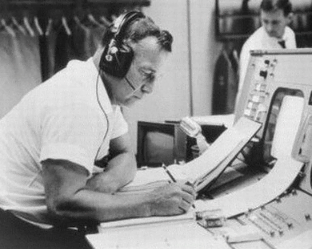
Summary
Albert M. Chop wore many hats in the field of communication as a newspaper reporter, a public relations officer in the aerospace industry, and a founding member of NASA's public relations office who served as Deputy Public Relations Director. He was a reporter in the Pentagon's Press Section in Washington, DC who assisted with media inquiries concerning UAPs.
Background
Chop began his career as a newspaper reporter in Dayton, Ohio. Following World War II, he went to work for the Press Section of the Air Materiel Command at Wright-Patterson AFB. Starting in 1951, he spent two years at the Air Force press desk at the Pentagon before leaving for a new venture with Douglas Aircraft in Santa Monica, California, which was a post he held from 1953 to 1962.
Chop was in the radar control room at Washington National Airport on July 26, 1952, when numerous UAPs were tracked on radar in restricted airspace and jet interceptors were scrambled. This led to Chop’s next job dealing with UAP. Air Force Public Relations Office Chief Colonel DeWitt Searles, at the request of General Samford and General Sory Smith of the Office of Public Information at the Defense Department, transferred Chop from Dayton to the Pentagon's Press Section to assist with the growing number of media inquiries concerning UAPs.¹
This incident was one of several in the area, and are often referred to as the Washington flap, the Washington National Airport Sightings, or the Invasion of Washington. The events led to numerous reports and public interest. The most witnessed sightings took place on consecutive weekends of July 19–20 and July 26–27, which was when Chop was working the radar control room on July 26. The media ran with the story and it became front page news nationally, but Air Force officials were quick to dismiss the incident as unusual weather conditions.²
Originally a skeptic of flying saucers, Chop was able to talk to top government officials who had become convinced that many UAP sightings represented real craft of unknown origin.1 In 1956, his UAP project involvement became the subject of the feature-length motion picture "Unidentified Flying Objects: The True Story of Flying Saucers."³
Legacy
Chop helped NASA organize its public affairs office, worked on Project Gemini and provided voice commentary during the Gemini missions. In 1971, Chop was named manager of the motivation and training division of NASA's D.C. headquarters. He may be best remembered for pioneering the "Snoopy Program," a NASA safety program that featured popular “Peanuts” icon Snoopy on posters and promotional materials.⁴ Chop went on to work for the Atomic Energy Commission from 1975-77. Chop died on January 15, 2006.
References
3. UFO Movie http://ufothemovie.blogspot.com
4. Collect Space http://www.collectspace.com/news/news-021400a.html